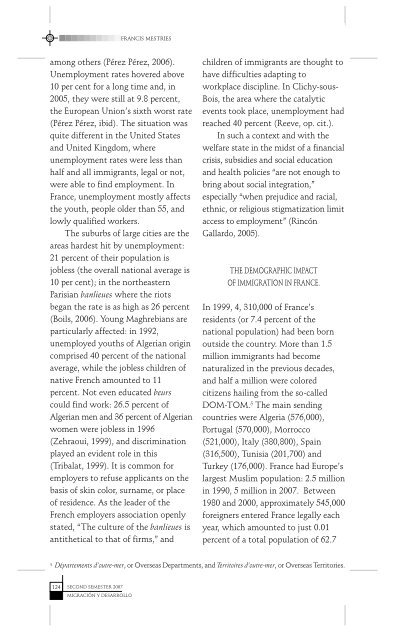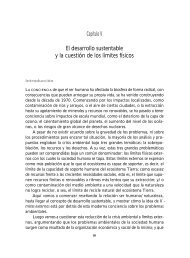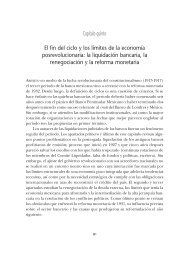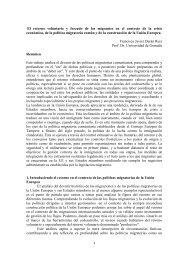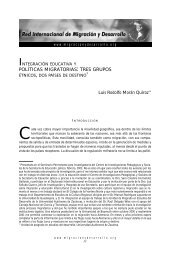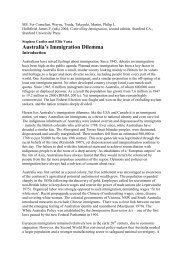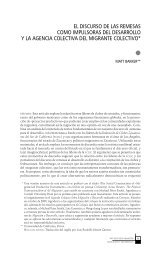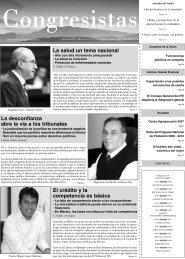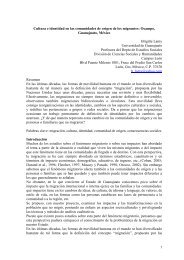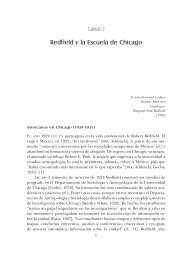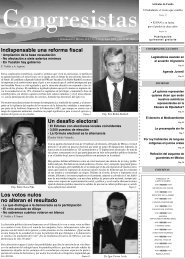the french autumn riots of 2005 and the crisis of republican integration
the french autumn riots of 2005 and the crisis of republican integration
the french autumn riots of 2005 and the crisis of republican integration
You also want an ePaper? Increase the reach of your titles
YUMPU automatically turns print PDFs into web optimized ePapers that Google loves.
FRANCIS MESTRIESamong o<strong>the</strong>rs (Pérez Pérez, 2006).Unemployment rates hovered above10 per cent for a long time <strong>and</strong>, in<strong>2005</strong>, <strong>the</strong>y were still at 9.8 percent,<strong>the</strong> European Union’s sixth worst rate(Pérez Pérez, ibid). The situation wasquite different in <strong>the</strong> United States<strong>and</strong> United Kingdom, whereunemployment rates were less thanhalf <strong>and</strong> all immigrants, legal or not,were able to find employment. InFrance, unemployment mostly affects<strong>the</strong> youth, people older than 55, <strong>and</strong>lowly qualified workers.The suburbs <strong>of</strong> large cities are <strong>the</strong>areas hardest hit by unemployment:21 percent <strong>of</strong> <strong>the</strong>ir population isjobless (<strong>the</strong> overall national average is10 per cent); in <strong>the</strong> nor<strong>the</strong>asternParisian banlieues where <strong>the</strong> <strong>riots</strong>began <strong>the</strong> rate is as high as 26 percent(Boils, 2006). Young Maghrebians areparticularly affected: in 1992,unemployed youths <strong>of</strong> Algerian origincomprised 40 percent <strong>of</strong> <strong>the</strong> nationalaverage, while <strong>the</strong> jobless children <strong>of</strong>native French amounted to 11percent. Not even educated beurscould find work: 26.5 percent <strong>of</strong>Algerian men <strong>and</strong> 36 percent <strong>of</strong> Algerianwomen were jobless in 1996(Zehraoui, 1999), <strong>and</strong> discriminationplayed an evident role in this(Tribalat, 1999). It is common foremployers to refuse applicants on <strong>the</strong>basis <strong>of</strong> skin color, surname, or place<strong>of</strong> residence. As <strong>the</strong> leader <strong>of</strong> <strong>the</strong>French employers association openlystated, “The culture <strong>of</strong> <strong>the</strong> banlieues isanti<strong>the</strong>tical to that <strong>of</strong> firms,” <strong>and</strong>children <strong>of</strong> immigrants are thought tohave difficulties adapting toworkplace discipline. In Clichy-sous-Bois, <strong>the</strong> area where <strong>the</strong> catalyticevents took place, unemployment hadreached 40 percent (Reeve, op. cit.).In such a context <strong>and</strong> with <strong>the</strong>welfare state in <strong>the</strong> midst <strong>of</strong> a financial<strong>crisis</strong>, subsidies <strong>and</strong> social education<strong>and</strong> health policies “are not enough tobring about social <strong>integration</strong>,”especially “when prejudice <strong>and</strong> racial,ethnic, or religious stigmatization limitaccess to employment” (RincónGallardo, <strong>2005</strong>).THE DEMOGRAPHIC IMPACTOF IMMIGRATION IN FRANCE.In 1999, 4, 310,000 <strong>of</strong> France’sresidents (or 7.4 percent <strong>of</strong> <strong>the</strong>national population) had been bornoutside <strong>the</strong> country. More than 1.5million immigrants had becomenaturalized in <strong>the</strong> previous decades,<strong>and</strong> half a million were coloredcitizens hailing from <strong>the</strong> so-calledDOM-TOM. 5 The main sendingcountries were Algeria (576,000),Portugal (570,000), Morrocco(521,000), Italy (380,800), Spain(316,500), Tunisia (201,700) <strong>and</strong>Turkey (176,000). France had Europe’slargest Muslim population: 2.5 millionin 1990, 5 million in 2007. Between1980 <strong>and</strong> 2000, approximately 545,000foreigners entered France legally eachyear, which amounted to just 0.01percent <strong>of</strong> a total population <strong>of</strong> 62.75Départements d’outre-mer, or Overseas Departments, <strong>and</strong> Territoires d’outre-mer, or Overseas Territories.124SECOND SEMESTER 2007MIGRACIÓN Y DESARROLLO


